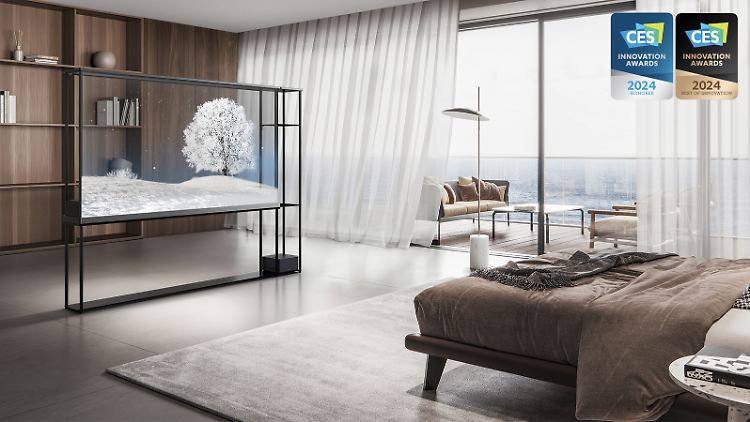Look through it!
Transparent televisions are becoming practical
This audio version was artificially generated. More info | Send feedback
Switched off televisions could soon no longer be annoying black surfaces. Samsung and LG are presenting transparent televisions at the CES technology trade fair, while Zeiss is presenting a film that turns glass panes into displays.
Looking at it and seeing through it – this is what the future of the screen looks like. Three companies, Zeiss, Samsung and LG, are showing technology for transparent screens at the Consumer Electronics Show in Las Vegas. And some of it is not that far from being ready for the market.
Film makes glass surfaces a display
With a thin, transparent film, Zeiss wants to turn almost any glass surface into a screen. It contains tiny display technology that is supposed to conjure up image content on glass panes, car windows or actual transparent computer screens. Zeiss calls the whole thing futuristic holography technology and shows scenes in which a man creates an entry in his digital calendar in front of a large panoramic window.
With the Holocam, Zeiss is also showing an almost invisible camera, also in the form of a thin film. It contains a technology that redirects incident light via light transmission to an image sensor installed elsewhere. The film can be installed, for example, on a pane of glass or in the middle of a screen. According to Zeiss, you could finally look the other person directly in the eyes during video calls.
Self-illuminating diodes to see through


The LG OLED T provides a clear view of the bookshelf.
(Photo: LG Electronics)
LG has plenty of traditional flat screens on offer and the Koreans are particularly strong in the area of self-illuminating OLEDs. LG now also has a transparent OLED screen. When it's turned off, you can see through it, otherwise the 4K screen shows high-resolution images and videos that feel like they're floating in space. A black contrast screen can be rolled out behind the screen for watching films.
According to LG, the TV called OLED T with a 77-inch screen diagonal will be sold this year. No information has yet been given about the price. Other areas of application for the transparent screens could also be cash register systems or electronic advertising boards.
Clear micro LED from Samsung
There is also no price tag printed on Samsung's transparent screen, nor has it been explained when the technology will be available to television buyers. In contrast to LG's organic LED, Samsung relies on transparent micro-LED screens. The displays should therefore be brighter and less influenced by ambient light. The three variations shown, from slightly tinted to transparent, are around one centimeter thick and borderless. One application for this could, for example, be to display additional information on glass during sporting events.


